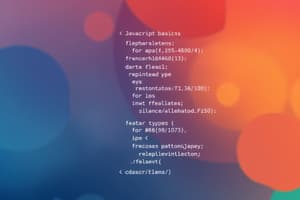Podcast
Questions and Answers
Which of the following correctly describes the Boolean data type?
Which of the following correctly describes the Boolean data type?
- It indicates a variable that has not been assigned a value.
- It is used for making decisions with two possible values. (correct)
- It allows for an infinite number of combinations.
- It can hold multiple values including strings and numbers.
What distinguishes the BigInt data type from the standard number type?
What distinguishes the BigInt data type from the standard number type?
- BigInt is used exclusively for text data.
- BigInt can have a range that is always smaller than standard numbers.
- BigInt allows for larger numerical values. (correct)
- BigInt can only represent decimal numbers.
How must strings be formatted in JavaScript?
How must strings be formatted in JavaScript?
- Strings must be enclosed in quotes. (correct)
- Strings can be written without any enclosing symbols.
- Strings must be surrounded by braces.
- Strings require an integer prefix.
What does null represent in JavaScript?
What does null represent in JavaScript?
Which of the following statements about the symbol data type is true?
Which of the following statements about the symbol data type is true?
Flashcards
JavaScript Primitive Types
JavaScript Primitive Types
Seven basic data types in JavaScript: string, number, Boolean, null, undefined, BigInt, and symbol.
String Data Type
String Data Type
Used to represent text; enclosed in quotes.
Number Data Type
Number Data Type
Represents numerical values.
Boolean Data Type
Boolean Data Type
Signup and view all the flashcards
Null vs. Undefined
Null vs. Undefined
Signup and view all the flashcards
Study Notes
Primitive Data Types in JavaScript
- JavaScript has seven primitive data types: string, number, Boolean, null, undefined, BigInt, and symbol.
- Strings represent text, while numbers represent numerical values.
- Strings must be enclosed in quotes. Numbers are written as plain numerical values.
- Strings have a theoretically infinite length, while numbers have a limited range.
Boolean
- Boolean values can be either
trueorfalse. - These are used in conditional statements to control program flow.
Null and Undefined
nullrepresents the intentional absence of a value.undefineddesignates a variable that has not been assigned a value.
BigInt
BigInthandles values larger than the standard number type can represent.
Symbol
Symbolvalues are unique and prevent naming conflicts.
Studying That Suits You
Use AI to generate personalized quizzes and flashcards to suit your learning preferences.




